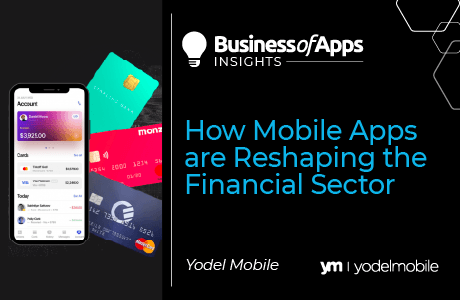
A changing industry environment, an increasingly crowded market, a global pandemic, and new consumer expectations are all contributing to radically altering the mobile streaming video on-demand (SVoD) entertainment space. These dynamic shifts are making it more challenging than ever for streaming services to remain distinctive, retain strong customer appeal, and adapt to accelerating technological advancements.
The entertainment industry has been significantly impacted by the pandemic, with lockdowns vastly increasing entertainment app usage and spearheading the shift from cinema and traditional broadcasting to streaming. This has meant that mobile apps in this space will have to deal with unpredictable spikes in users, increased competition and increasing consumer expectations. To combat this, Yodel Mobile has broken down the key advancements in the entertainment industry and interwoven them with mobile app marketing strategies, based on their clients in the industry, that will help app marketers not only understand but also take advantage of future trends in this space.
The Entertainment Industry Today
For the first time, streaming service subscriptions have overtaken conventional TV subscriptions, and are expected to grow consistently at a strong annual rate of 10% to 15% throughout most of the coming decade.
Additionally, entry of younger demographics as dedicated streaming consumers brings with it a pivot to Gen Z and Millennial preferences: over 80% of those in Generation Z, and nearly 90% of Millennials subscribe to video on-demand services.
These are two significant trends that showcase a major shift in both who is predominantly consuming media and video, and how. Using data-insights to understand your target audience and the channels they are using is crucial to setting up successful organic growth strategies and paid campaigns.
The Pandemic: Crisis & Opportunity
Another critical factor in the evolution of the streaming industry this year is the COVID-19 pandemic, which has devastated streaming’s cinema competitors, and resulted in massive growth in consumer demand for on-demand entertainment. This underscores a paradigm shift from traditional entertainment consumption to mobile SVoD channels.
Mobile app usage rose by 40% YoY to a new record of 200 billion hours in one month during the second quarter of 2020, largely due to the effects of lockdown and the pandemic in restricting consumers’ daily activities. Meanwhile, viewing figures for streaming services were up 71% YoY.
This presents a challenging but invaluable opportunity to expand streaming services’ customer bases and gain increased market penetration. Ultimately, streaming services that take advantage of this situation, through the implementation of a holistic app growth marketing strategy ahead of their competition, will likely emerge as dominant players in the market. It is important to remember that this will also play a significant part in maintaining growth as lockdowns ease and previous spikes in app usage return to normal.
Understanding your Users
To start with you need to ensure that you are tracking ALL of your data. Without the right mobile tool stack in place, you may be missing valuable information. For instance, tracking the full user journey (including the categories users select or user search phrases) will help you to identify any blind spots, produce quick wins and allocate spend effectively.
You should also be creative when it comes to applying these data insights. For example, by looking at which times of the day users are most likely to interact with your app could also help you with creating a personalized push notification strategy to maximize user engagement.
- When are your users most likely to explore programs for a new series?
- When are your users most likely to watch a movie?
Maximizing Organic User Acquisition
You also need to focus on other ways to maximize the organic growth of your app, such as having a comprehensive social sharing strategy in place. By encouraging users to share the app at key points of the user journey (e.g. after watching 3 episodes) you are increasing the virility of your app, creating self-sustaining growth. When combined with an effective paid media strategy, this can also lower the overall Cost Per Customer (CPC).
Ultimate App Growth Guide 2025
Boost your app’s success with the Ultimate App Growth Guide! 🚀 Expert insights, proven strategies & must-know tips. Download now!
Master app growthRevolution to Evolution: The Streaming Singularity
As the space becomes saturated and fragmented, 47% of American streaming consumers stated that they are frustrated by the growing number of subscriptions and services required to watch what they want.
The resulting increase in consumer fatigue and streaming singularity provide compelling reasons to cut through the competition by increasing your app’s visibility using an app review strategy, using positive reviews as a means to gain social proof and ensuring users are catered to when committing to the app by responding to user feedback. Positive user sentiment on the App Store can go a long way to persuading new users to download your app, meanwhile addressing user issues can help you identify pain points and ensure your users feel heard.
Implementing an App Review Strategy
Implementing a review prompting strategy will not only provide you with invaluable feedback on your app and possible pain points in the user journey, but an increase in positive reviews will also drive a greater number of users to download your app in the long-term.
When requesting users to review your app, prompts need to be contextual and timely, placed at points where the user has just completed an action and is feeling motivated and happy. Many apps interrupt the user’s desired task, which is more likely to result in the user exiting the app as opposed to leaving a review.
Users with the strongest reactions will be the most likely to review your app – leading to a mix of very positive and very negative reviews. There needs to be a strategy which deals with happy and unhappy customers in different ways. Unhappy users can be directed away from the app store to private support platforms whilst happy users need to be encouraged to go to the app store to rate and review.
Here are a few key tips when looking to implement an app review feedback strategy:
- Asking users whether they are happy is 5-10x more effective than just asking them to rate the app
- A/B testing can be a powerful tool which aims to drive higher conversions
- Unhappy users who are asked about their opinion are >400% more likely to return to the app than the average user. After feeling heard by the company, a user can change their opinion drastically
Preparing for Long-Term App Growth
An innovative app marketing strategy enabled by in-depth data analysis is integral to maintaining an edge in the entertainment space. As traditional broadcasting channels and new digital-savvy on-demand services enter the market and increase competition, it is essential to maximize app visibility and ensure your app stands out in the crowd. Meanwhile, consumer fatigue will undoubtedly increase alongside market saturation so an effective app review strategy is crucial, not only to increase the number of positive reviews but also to build out long-lasting relationships with users by addressing their feedback.
As spikes in user acquisition and engagement continue for the foreseeable future, it is also important to prevent user drop off in-app by ensuring your app has an easy and intuitive user journey that offers tailored suggestions and promotes continued engagement with your app. Read more on ensuring your app has a seamless user journey here.
If you have any questions or need support regarding a mobile app in the entertainment industry, please get in touch with the Yodel Mobile growth team here.









